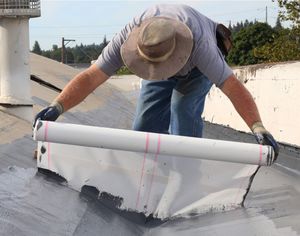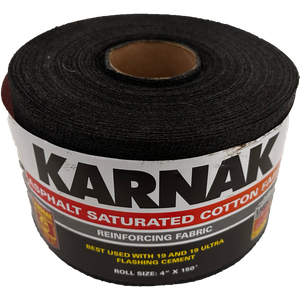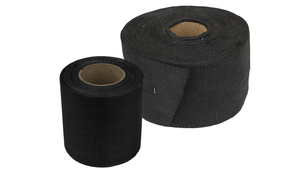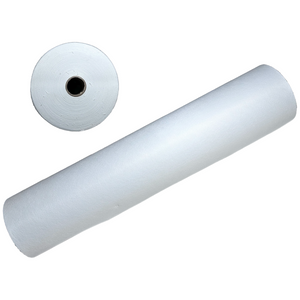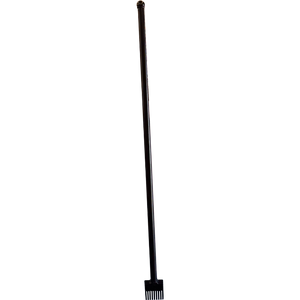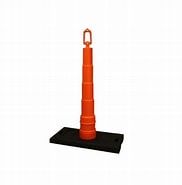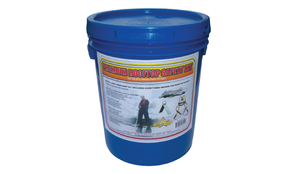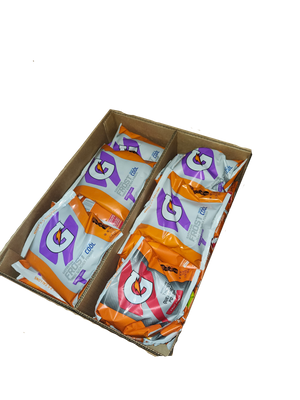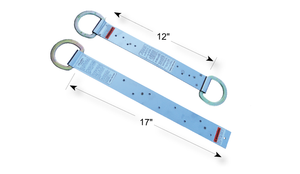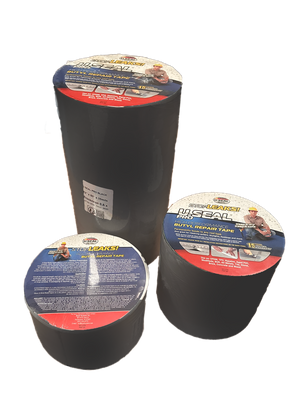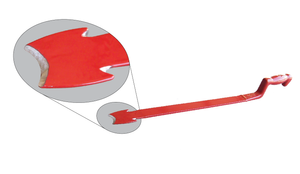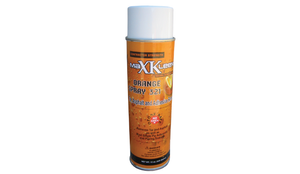Our Blog
Tear-off Tools Compared: Tear-off 54 vs. 46 vs. 22 – What's the Difference?
When it comes to roof demolition and removal, not all tear-off tools are created equal. Whether you're stripping old shingles, prying up stubborn nails, or cleaning off underlayment, the right tear-off bar can make a big difference in speed, leverage, and fatigue. Three of the most commonly used models in the roofing world are the Tear-off 54, Tear-off 46, and Tear-off 22. Each has a specific strength depending on the job size, roof pitch, and user preference.
Let’s break down what sets each of these tools apart and which one might be the best fit for your crew.
🔩 What Are Tear-off Tools?
Tear-off bars (also known as shingle removers or roofing spades) are designed to rip up shingles, nails, and roofing felt in wide, efficient passes. They often feature serrated blades, long handles for leverage, and reinforced tines for heavy-duty prying.
The numbers 54, 46, and 22 refer to the length of the bar in inches, which directly impacts the tool’s leverage, reach, and usability.
🛠️ Tear-off 54: Maximum Leverage, Minimal Back Strain
Length: 54 inches
moreRoof Reinforcement Membranes Explained: Cotton vs. Polyester vs. Fiberglass
Lane N
🔑 Key Takeaway:
When it comes to reinforcing roofing and waterproofing systems, the three most widely used membranes are cotton fabric, polyester fabric, and fiberglass mat. Each has its own strengths, weaknesses, and ideal use cases. Understanding the difference between these materials helps contractors choose the best membrane for durability, flexibility, cost, and system compatibility.
What Are Reinforcement Membranes in Roofing?
Reinforcement membranes are fabric-like materials that are embedded in roofing coatings or layered within membranes to improve strength, flexibility, crack resistance, and waterproofing integrity. They’re essential in:
-
Cold-applied coatings
-
Torch-down bitumen systems
-
Liquid roofing
-
Roof repairs and flashing details
The three most common types of reinforcement membranes are made from cotton, polyester, or fiberglass. While they serve a similar function — strengthening the roof system — their material makeup changes how they perform in the field.
moreCotton Fabric Membrane for Roofing: A Traditional Solution with Surprising Strength
Lane N
🔑 Key Takeaway:
Cotton fabric membrane is a time-tested, biodegradable reinforcement material used in cold-applied roofing systems, bituminous coatings, and roof repairs. While less common than fiberglass or polyester today, cotton remains a reliable option for certain waterproofing applications where absorption, eco-friendliness, and adhesion performance are essential.
What Is a Cotton Fabric Membrane?
Cotton membrane, also known as cotton reinforcing fabric, is a woven cloth made from natural cotton fibers. It’s typically used as an embedded reinforcement within asphalt or tar-based roofing systems, or within emulsion coatings for roof repair.
Cotton fabric is absorbent, flexible, and adheres well to various coatings. Because it's made from natural fibers, it provides excellent coating retention, allowing the sealant or roofing cement to soak in and bond tightly.
Traditionally used in built-up roofing (BUR) systems and hot mop applications, cotton membrane is seeing renewed interest for eco-conscious projects and heritage building restorations.
moreFiberglass Membrane for Roofing: What It Is, How It’s Used, and Why It Matters
Lane N
🔑 Key Takeaway:
Fiberglass membrane is a strong, lightweight, inorganic fabric used in roofing and waterproofing systems to provide dimensional stability, fire resistance, and long-lasting performance. It’s particularly effective in bituminous, cementitious, and acrylic-based roofing systems.
What Is a Fiberglass Membrane?
A fiberglass membrane is a woven or non-woven fabric made from fine glass fibers, formed into a mesh or mat. It's engineered to provide strength and stability to waterproofing systems. Unlike organic materials, fiberglass is rot-proof, fire-resistant, and chemically stable, making it an ideal component in long-term roofing applications.
Fiberglass membranes are often sold in rolls and are available in various thicknesses (commonly from 50g/m² to 120g/m²) to suit different reinforcement needs.
Fiberglass Membrane vs. Polyester Membrane
While both fiberglass and polyester membranes are used for reinforcement, they behave very differently in roofing applications.
moreWhat Is Polyester Membrane? Everything You Need to Know About This Reinforcement Hero in Roofing and Waterproofing
Lane N
🔑 Key Takeaway:
Polyester membrane is a non-woven, high-strength reinforcement fabric used in a variety of roofing, waterproofing, and sealing systems to increase durability, flexibility, and weather resistance. It’s commonly embedded in liquid-applied coatings and bituminous membranes to prevent cracking and extend service life.
🔷 What Is a Polyester Membrane?
A polyester membrane, also known as poly reinforcement fabric or poly mat, is a spun bond, non-woven fabric made from long polyester fibers that are bonded together using heat and pressure. It is specifically engineered for use in roofing and waterproofing systems to reinforce and stabilize coatings or membranes.
It comes in rolls, usually ranging in width from 4" (for flashing details) up to 40" or more for full-surface coverage. The weight of the membrane is measured in grams per square meter (g/m²), with common options being 100g/m², 150g/m², and 200g/m² depending on the required strength and flexibility.
🔷 Why Use Polyester Membrane?
Polyester membrane solves several critical issues in roof systems:
moreWhat Is a Core Cutter in Commercial Roofing? (Full Guide for 2025)
Lane N
🧱 What Is a Core Cutter in Commercial Roofing? (Full Guide for 2025)
TL;DR: A core cutter is a specialized tool used in commercial roofing to extract a cylindrical section of roof membrane, insulation, and substrate for analysis. It's crucial for testing moisture levels, core samples, and performing roof inspections before repairs or replacements.
🔍 What Is a Core Cutter?
A core cutter is a cylindrical cutting tool used to remove a sample—or “core”—from a commercial roof. It’s essential for:
-
Roof system evaluation
-
Moisture analysis
-
Warranty or insurance documentation
-
Testing insulation type and thickness
Core cutters are often used in conjunction with roofing moisture meters and roof core sample kits.
🛠️ Need a core cutter now?
🏢 Why Core Cutters Matter in Commercial Roofing1. Roof Inspections Before Replacement
Before committing to a full tear-off or retrofit, roofers must know what they’re working with. Core cutters help:
moreThe Tine Bar: A Roofer’s and Contractor’s Secret Weapon
When it comes to roofing, construction, and demolition, having the right tool makes all the difference. Jobs that involve heavy lifting, prying, or tight, precise cuts require more than just brute strength—they require leverage, accuracy, and durability. That’s exactly where the Tine Bar with 3.5" Blade comes in.
This rugged tool may look simple, but it delivers serious performance. Whether you’re a roofer tearing off shingles, a contractor popping baseboards, or a demolition expert removing stubborn fasteners, the tine bar deserves a place in your toolbox. In this post, we’ll dive into the many uses of a tine bar, how it benefits your workflow, and why this compact yet powerful tool should be a go-to for professionals.
What Is a Tine Bar?
A tine bar is a hand tool designed for lifting, prying, and cutting with precision and force. It features a short, sharp blade—3.5 inches long in this case—that’s built to wedge into tight spaces and provide strong leverage. Made with heavy-duty construction, the tine bar is built to withstand harsh environments and repetitive use on the jobsite.
moreHeavy-Duty 42 Gallon Contractor Bags – The Roofer’s Cleanup Essential
When it comes to roofing, one thing is certain—there will be a mess. Shingles, nails, underlayment scraps, and all kinds of debris pile up fast during a tear-off or repair job. That’s where our Heavy-Duty 42 Gallon Contractor Bags come in. Built to withstand the toughest jobsite abuse, these bags are a must-have for roofing contractors who need a cleanup solution that won’t rip, split, or give out under pressure.
Each box contains 20 industrial-strength bags, each measuring 32" x 50" with a massive 42-gallon capacity. Made from 3 mil thick material, these contractor bags are engineered to handle heavy, sharp, and bulky roofing debris with ease. Whether you’re removing three-tab shingles, tossing out broken tile, or cleaning up old felt and flashing, these bags are up to the challenge.
Built for Roofing Demolition
Roof tear-offs are some of the most demanding tasks in construction. The materials are heavy, jagged, and dusty—and they often tear right through average trash bags. That’s why our contractor bags are made for heavy-duty demolition and roofing debris. The 3 mil thickness gives them extra puncture and tear resistance, which is critical when you’re filling them with nails, splintered wood, metal scraps, or chunks of tile.
moreThe Ultimate Guide to PVC Roofing: Everything You Need to Know About One of the Best Flat Roofing Solutions Available
Lane N
The Ultimate Guide to PVC Roofing: Everything You Need to Know About One of the Best Flat Roofing Solutions Available
In the world of roofing systems, PVC roofing stands out as one of the most resilient, energy-efficient, and cost-effective options for flat and low-slope roofs. Whether you're a commercial property owner, a contractor, or a homeowner considering a durable flat roofing system, this guide is designed to provide you with every detail you'll need. From materials and installation to cost comparisons, environmental impact, and maintenance, this is the comprehensive deep-dive you're looking for.
1. What is PVC Roofing? Technical Definition
PVC roofing, or Polyvinyl Chloride roofing, is a single-ply thermoplastic membrane made from a specialized blend of plasticizers and stabilizers. These components are engineered for flexibility, UV resistance, and long-term structural integrity. The standard commercial-grade membrane is reinforced with a polyester fabric (scrim) to increase tensile strength.
Structural Composition
Top Layer: UV-resistant PVC compound.
Scrim Layer (middle): High-tenacity polyester reinforcement for dimensional stability.
more
The Unsung Hero of Roofing Safety: Why Rooftop Stanchions Could Save Your Life
Lane N
Rooftop stanchions save lives because they significantly reduce the risk of falls—the leading cause of serious injury and death in the roofing industry.
Here's why they matter:
Preventing Fatal Falls
Falls account for the most fatalities on construction and roofing sites. Rooftop stanchions create secure, stable anchor points for guardrails or safety lines, effectively creating a protective barrier that prevents workers from accidentally stepping or falling off a roof edge.
Immediate Fall Arrest
In situations where a worker slips, stumbles, or loses footing, rooftop stanchions paired with personal fall arrest systems (like harnesses and lanyards) immediately stop the fall. This drastically reduces injuries compared to unprotected falls.
Clear Safety Boundaries
Stanchions visually outline safe working zones on a rooftop. This clear indication helps workers remain aware of their surroundings, significantly reducing accidental falls or unsafe behaviors caused by distraction or misjudgment.
Supporting Worker Confidence and Productivity
When workers feel safe, they're more focused, productive, and able to perform efficiently. Stanchions don't just save lives—they foster a secure working environment, encouraging safer behaviors and better decision-making on rooftops.
more
What Even Is Torch Down Roofing?
Lane N
What Even Is Torch Down Roofing?
Alright, let’s start with the basics.
Torch down roofing is a type of roof system made specifically for flat or low-slope roofs. It’s called "torch down" because a big flame torch is used to melt the roofing material so that it sticks right onto the roof surface. Think of it like laying down a giant sheet of super strong black tape and using fire to make it stick forever.
It’s made from something called modified bitumen. That’s a fancy term for asphalt that’s been mixed with rubber or plastic to make it more flexible and waterproof. Kinda like how Silly Putty is just bendy rubbery stuff—that’s what this is, but for roofs.
Why Do People Use Torch Down Roofing?
So why would someone choose to melt asphalt onto their roof with fire? Sounds wild, right?
Here’s why:
It’s super waterproof. Like, rain, snow, sleet—bring it on. This stuff keeps it all out.
It’s durable. It can last 15–20 years or even more if you take care of it.
It handles the sun well. Some types come with a layer that reflects UV rays.
more
PVC Roofing: What It Is, How It's Installed, and Where It Works Best
Lane N
PVC Roofing: What It Is, How It's Installed, and Where It Works Best
Key Takeaways:
-
PVC (Polyvinyl Chloride) roofing is a type of single-ply membrane used primarily on commercial flat roofs.
-
It offers exceptional durability, chemical resistance, and energy efficiency.
-
Ideal applications include restaurants, airports, factories, and roofs with grease or chemical exposure.
-
Compared to TPO and EPDM, PVC stands out in strength and longevity, though at a higher initial cost.
What Is PVC Roofing?
PVC roofing is a single-ply thermoplastic membrane made from polyvinyl chloride, a synthetic plastic polymer. Designed specifically for flat or low-slope commercial and industrial roofs, PVC roofing membranes are reinforced with polyester or fiberglass to improve their strength and durability.
The system is heat-welded at seams, forming a watertight, monolithic surface. This welding method creates a bond that's stronger than glued or taped seams, making PVC one of the most leak-resistant roofing systems available.
moreTwo Roofing Safety Kits — One Trusted Source
At Roofing Tools Online, we carry two safety kits tailored to different needs and budgets:
🔒 Premium Safety Kit in a Bucket
Designed for long-term use and rugged jobsite performance, this kit includes:
-
1x Full Body Harness
-
1x Heavy-duty 5/8" x 50 ft. White Polydac Rope
-
1x 3' Soft Pack Lanyard with 5/8" Manual Rope Grab
-
1x Hinged, Reusable Roof Peak Anchor
Why choose the premium kit?
-
The white polydac rope is softer, more flexible, and easier to handle in the field.
-
The rope grab and lanyard offer controlled vertical movement and shock absorption.
-
The hinged anchor can be mounted flat or on peaks and reused again and again.
-
The bucket keeps your gear clean and easy to store between jobs.
You can buy the premium safety kit in a bucket here.
more
Why Gatorade Is a Roofer’s Best Friend in the Summer Heat
Why Gatorade Is a Roofer’s Best Friend in the Summer Heat
When you're working on a rooftop in the middle of July, it's not just hot — it's brutal. Shingles radiate heat like a skillet, metal panels burn through gloves, and your body feels like it's baking from the inside out. In these conditions, water alone might not cut it. That’s where Gatorade becomes more than a sports drink — it’s a survival tool.
The Reality of Roofing in Summer
Roofers routinely work in conditions that push the body to the edge. On a 90°F day, roof surface temperatures can easily reach 130–160°F, especially on dark asphalt shingles or metal panels. Combine that with the physical strain of lifting, bending, hammering, and hauling materials — and you're looking at serious fluid and electrolyte loss every hour.
The risks? Dehydration, heat exhaustion, cramps, and even heat stroke — all of which can take a roofer off the jobsite, or worse, land them in the ER.
Water Is Good — But Not Always Enough
There’s no debate: drinking water is crucial. But water alone doesn’t replace the electrolytes your body loses through heavy sweating — especially sodium, potassium, and magnesium. When those levels drop, your muscles cramp, your focus slips, and your energy tanks.
moreRoofers Choice Hand Seamers: The Right Tools for Precision Metal Roofing
When you're working on a metal roof, accuracy and control aren't optional — they're essential. One wrong bend, one sloppy flange, and you're dealing with leaks, callbacks, or costly rework. That’s why pros reach for the hand tools that don’t quit. Enter Roofers Choice — a trusted name in tools designed by roofers, for roofers.
In this blog, we’re spotlighting three of Roofer’s Choice’s most essential hand seamers:
-
The 3" Hand Seamer
-
The 3" Offset Hand Seamer
-
The 6" Hand Seamer
Each of these tools is built for specific tasks, and when used together, they make bending, folding, and finishing sheet metal cleaner, faster, and more accurate — whether you're working on a standing seam panel, flashing detail, or a custom trim install.
What Makes Roofers Choice Tools Different?
Roofers Choice doesn’t make general-purpose metalworking tools. These seamers are purpose-built for roofing — meaning they’re optimized for the unique demands of standing seam panels, flashing, fascia, and metal trim.
You’ll find:
-
Tempered steel jaws that hold their shape under pressure
more
How to Correctly Install a Double D Roof Anchor
Lane N
Looking to safely secure yourself while working on a roof? The Double D Anchor is one of the most reliable fall protection solutions out there—and it’s easy to install when done right. In this guide, we’ll walk you through how to properly install a Double D Roof Anchor for maximum safety and code compliance.
✅ TL;DR: To correctly install a Double D Anchor, find a structural rafter, remove a section of shingles, use the right lag bolts, and install under the ridge cap. Always follow OSHA safety standards.
🛡️ What Is a Double D Roof Anchor?
A Double D anchor is a permanent or temporary fall arrest anchor that installs over the roof ridge, creating two D-rings—one for each side of the roof. This allows for maximum mobility and fall protection coverage on both slopes.
🧠 Why it’s popular:
-
Works with composition or wood shake roofs
more
What is PVC Roofing? A Durable, Energy-Efficient Solution for Flat Roofs
Lane N
PVC roofing (Polyvinyl Chloride roofing) is a single-ply membrane widely used in commercial and residential flat or low-slope roofing due to its exceptional durability, chemical resistance, energy efficiency, and ease of installation.
If you're a contractor, property owner, or roofer exploring long-lasting roofing options, PVC is one of the top contenders, especially for buildings that demand leak resistance, low maintenance, and reflective surfaces to cut down on cooling costs.
In this article, we’ll break down:
-
What PVC roofing is made of
-
The installation process (step-by-step)
-
Benefits and drawbacks
-
How it compares to TPO and EPDM
-
Which tools and accessories you’ll need
-
Tips for first-time installers
What Is PVC Roofing Made Of?
PVC roofing is a thermoplastic membrane composed of two layers of PVC material with a polyester reinforcement scrim in between. These layers often include additives that make the membrane:
-
UV-resistant
-
Flexible
-
Fire-retardant
more
Sealing the Deal: How to Use Butyl Tape to Repair Small Roof Leaks
When it comes to roof repairs, small leaks can lead to big problems if ignored. Whether it’s a minor drip near a vent pipe or a seam starting to separate on a flat roof, time is not on your side. The longer moisture is allowed to seep in, the more likely it is to cause structural damage, mold, and insulation issues.
Fortunately, you don’t need a full crew and a day’s worth of labor to fix a small leak. With the right tools and materials — like high-quality butyl tape — you can handle minor roof leaks quickly, cleanly, and effectively. Let’s dive into what butyl tape is, how it works, and how you can use it to stop leaks in their tracks.
What is Butyl Tape?
Butyl tape is a flexible, pressure-sensitive adhesive tape made from synthetic rubber. Unlike standard rubber adhesives, butyl has superior water resistance and airtight sealing capabilities, making it ideal for sealing roofs, windows, RV seams, and HVAC systems.
Its biggest strength lies in its durability and ability to adhere to a variety of surfaces — metal, glass, plastic, and roofing materials like EPDM, TPO, and modified bitumen. It stays flexible in a wide range of temperatures and remains effective even after years of sun exposure and rain.
moreTear-Off Titans: Ripper-48 vs. Tear-Off 54 Roofing Tear-Off Tools
Eric S.
When it’s time to strip a roof, whether you're dealing with layers of aged shingles or heavy-duty underlayment, every roofer knows the importance of having the right tools for the job. Roofing tear-off tools are more than just metal and handles — they’re the first line of offense in a full roofing replacement, and using the wrong one can slow you down, wear you out, and make a tough job even harder.
Two of the most reliable options in the roofing world today are the Ripper-48 and Tear-Off 54. These roofing tear-off tools are engineered with the professional roofer in mind: they’re durable, efficient, and built to deliver serious results on both residential and commercial tear-offs.
Understanding Roofing Tear-Off Tools
Roofing tear-off tools are specialized devices used to remove shingles, nails, flashing, underlayment, and even membrane layers from rooftops. They’re designed to pry, rip, and lift stubborn roofing materials while minimizing damage to the roof deck.
Basic prybars can only take you so far. Professional-grade roofing tear-off tools, like the Ripper-48 and Tear-Off 54, give you the edge by maximizing leverage and minimizing effort — even on multilayer roofs or in challenging weather conditions.
moreRemoving Slate Roofing the Right Way: The Power of the Forged Slate Ripper
Eric S.
Slate roofing is a hallmark of old-world craftsmanship — durable, elegant, and built to last over a century when properly maintained. But even the most robust slate roof eventually needs repairs or full replacement. Whether you’re restoring a historic building or replacing a few damaged tiles, one tool stands above the rest when it comes to removing slate: the Forged Slate Ripper.
Why Slate Roofing Stands the Test of Time
Slate is a natural stone, and when used in roofing, it offers unmatched longevity and a timeless look. Many historic homes and buildings from the 19th and early 20th centuries still have their original slate roofs intact. The stone's resistance to fire, mold, frost, and wind makes it ideal for both durability and performance.
However, slate isn’t indestructible. Over decades, individual tiles can crack, loosen, or fall victim to improper installation or flashing failure. In these cases, removing the damaged slate without disturbing the surrounding tiles is critical. That’s where a forged slate ripper comes into play.
What Makes the Forged Slate Ripper Essential?
Removing slate isn’t like tearing off asphalt shingles — brute force will only break tiles and create more problems than it solves. A Forged Slate Ripper is designed for finesse and precision. With a 20-inch blade and a 6-inch handle, it delivers the reach and leverage necessary to navigate under tiles and sever hidden fasteners.
moreRoofers Choice Spray Paint: The Trusted Solution for a Professional Finish
Eric S.
When it comes to residential roofing, details matter. Whether you're working on a new install or doing touch-up work on flashing, vents, stacks, or valleys, the finish needs to be clean, consistent, and built to last. That’s where Roofers Choice Spray Paint shines. Known throughout the industry for high-quality performance and a reliable finish, this rust-resistant enamel spray paint is the go-to solution for roofing professionals who want to match aesthetics with durability.
Built for the Roof, Built to Last
What sets Roofers Choice Spray Paint apart from the average can off the hardware shelf is its roof-specific engineering. This is a premium enamel formula that’s rust-resistant, making it perfect for exposed metal components that take the brunt of the elements. From UV rays to moisture, it holds up under punishing conditions and keeps vents, stacks, and flashing looking sharp and clean for the long haul.
With one-coat coverage, Roofers Choice saves time on the job. It sprays on smooth, dries quickly, and requires no priming. This means less downtime and fewer cans used per job, which adds up to real savings for your crew and your bottom line.
moreTPO vs. EPDM Roofing: What’s the Difference and Which is Right for You?
Eric S.
When it comes to commercial flat roofing, there are two standout options that professionals turn to time and time again: TPO and EPDM. Both are single-ply membranes trusted for their performance, longevity, and ease of installation — but they’re very different materials. Understanding what sets them apart can help you make the best decision for your building, budget, and climate zone.
Let’s dig into the key differences, starting with what these roofing systems are made of and how they perform in the real world.
What Is TPO Roofing?
TPO, or Thermoplastic Olefin, is a type of single-ply membrane made from a blend of polypropylene and ethylene-propylene rubber. It was introduced in the 1990s as a cost-effective alternative to PVC roofing. TPO membranes are most commonly white, though gray and tan options exist. That bright white surface isn’t just cosmetic — it reflects sunlight, making TPO a highly energy-efficient “cool roofing” solution.
TPO membranes are installed using mechanical fasteners or adhesives and feature hot-air welded seams. Those heat-welded seams provide a watertight barrier and are one of TPO’s biggest selling points, particularly in areas prone to heavy rain or standing water.
more"What is PVC Roofing? A Complete Guide to One of the Industry's Most Durable Flat Roof Systems."
Eric S
What is PVC Roofing?
A Complete Guide to One of the Industry's Most Durable Flat Roof Systems
In the world of commercial and flat roofing systems, few materials have earned a reputation quite like PVC. Known for its durability, weather resistance, and low maintenance, PVC roofing has become a top choice for building owners, contractors, and architects alike. But what exactly is it? How does it compare to other roofing systems? And is it right for your next project?
In this comprehensive guide, we’ll break down what PVC roofing is, how it works, its pros and cons, and why it’s considered one of the most reliable roofing membranes in the industry.
What is PVC Roofing?
PVC roofing stands for Polyvinyl Chloride roofing — a single-ply roofing membrane made from a blend of synthetic plastic polymers. Originally developed in Europe in the 1960s, PVC roofing made its way to the U.S. market as a high-performance solution for flat and low-slope commercial roofing.
PVC membranes are usually white or light-colored and are typically installed in sheets that are either mechanically fastened, fully adhered, or ballasted. The seams are welded together using heat (hot-air welding), creating a watertight, monolithic surface that’s both durable and flexible.
moreMaxkleen Aerosol: The Fastest Way to Wipe Out Tar, Asphalt, and Adhesive Messes
In the roofing and construction world, messes happen — and not just any mess. We’re talking about the sticky, gunky, hard-to-remove stuff: tar, asphalt, and adhesive residue that clings to tools, equipment, hands, and work surfaces like it was welded on. That’s where Maxkleen Aerosol steps in as your cleanup hero. This powerful tar, asphalt, and adhesive remover comes packed in a convenient 15 oz. spray can and is powered by a tough orange extract cleaning solvent that gets the job done fast — and without damaging the environment.
What Is Maxkleen?
Maxkleen is a high-performance aerosol cleaning solvent specifically formulated to dissolve the most stubborn, sticky substances found on job sites. Whether you’re a commercial roofer, a general contractor, or just doing heavy-duty DIY work, Maxkleen works where water and soap don’t stand a chance.
Its natural citrus-based formula not only cuts through grime but leaves behind a fresh scent instead of that harsh chemical odor. Best of all, it’s ozone-safe, making it a smarter, cleaner choice for those who care about the environment — and their lungs.
What It Removes
moreRoofing Torches Explained: Choosing the Right Torch for the Job
Lane N
Wondering which roofing torch to use? Here’s everything you need to know — from the difference between a detail torch and a full-size burner to what makes our Magnum Torch line the best in the business. Every torch we sell comes with a high-quality hose and adjustable regulator, so you're ready to roll right out of the box.
Whether you're doing fine seam work on flashing or laying down a full modified bitumen cap sheet, we've got you covered with:
-
Long Handle Torch Kit w/ Electric Starter - Long Handle Torch Kit w/ Electric Starter
-
Magnum Detail Torch - Magnum Detail Torch
-
Magnum Torch - Magnum Torch
-
Magnum Torch Combo Kit - Magnum Torch Combo
In this article, we’ll break down what makes each torch unique, when to use a detail torch vs. a standard one, and how to get the most from your flame. Let’s fire it up.
moreStop Roof Leaks Fast: Why Roofers Choice 911 Emergency Roof Patch Is a Must-Have
Stop Roof Leaks Fast: Why Roofers Choice 911 Emergency Roof Patch Is a Must-Have
When the weather’s wild and water’s coming through the roof, you don’t have time to wait for perfect conditions. You need a solution that works right now, even if it’s raining, snowing, or you’re dealing with standing water. That’s where the Roofers Choice 911 Emergency Roof Patch (25 lbs.) comes in — a true lifesaver for emergency repairs on flat, built-up roofing systems.
What Is It?
The Roofers Choice 911 Emergency Roof Patch is a specially formulated, all-natural mineral compound that activates instantly upon contact with water. That means as soon as it hits moisture, it expands into a leak-sealing gel that plugs and patches like a pro. It's ideal for temporary emergency repairs, buying you time until a full fix or replacement can be done.
This isn’t your typical tar or sealant. It’s non-polluting, flame-resistant, and works under conditions that would defeat traditional roof repair materials.
Built for the Toughest Conditions
One of the standout features of the 911 Patch is its ability to be applied in any weather. Rainstorm? No problem. Snow? It works. Melting ice or standing water puddled on your flat roof? This product was made for that exact scenario.
moreTPO Roofing: What It Is, How It’s Installed & Tips for First-Timers
Lane N
TPO roofing — short for Thermoplastic Olefin — is one of the most popular roofing materials for flat and low-slope roofs, and for good reason: it's energy-efficient, affordable, durable, and easier to install than you might think.
If you’re new to roofing or just learning the ropes of TPO, this guide is for you. I’ll walk you through what it is, how it’s installed step-by-step (especially when glue is involved), and what tools you’ll need along the way. Let’s make sure you do it right the first time.
So… What Is TPO Roofing?
TPO is a single-ply white membrane that’s commonly used on commercial buildings. It comes in wide rolls — usually 10 to 12 feet — and it's either fully adhered (glued down), mechanically fastened, or ballasted (we’ll focus on glue-down here).
It’s made from a blend of polypropylene and rubber, and it's designed to reflect sunlight, which helps keep buildings cooler and reduces energy bills.
Some major perks of TPO:
-
Highly reflective: ENERGY STAR-rated for its cooling effect
-
Affordable: Less expensive than PVC but still heat-weldable
more
Mastering the Spud Bar: A Roofer’s Best Friend for Commercial Tear-Offs
Eric S
Mastering the Spud Bar: A Roofer’s Best Friend for Commercial Tear-Offs
When it comes to commercial roofing tear-offs, speed, efficiency, and muscle matter. Among the arsenal of roofing tools, one that’s often underestimated — but absolutely essential — is the spud bar. This rugged, no-frills tool plays a critical role in removing old roofing materials, especially built-up roofs (BUR) and modified bitumen systems. Knowing how to use a spud bar correctly can save time, energy, and wear-and-tear on your power tools.
What Is a Spud Bar in Roofing?
A spud bar, sometimes called a roofing spud bar or roof scraper, is a heavy-duty steel bar with a flat, sharpened blade on one end and a long handle for leverage. It’s specifically designed to remove embedded roofing materials like asphalt, gravel, and tar, especially when those layers cling stubbornly to the roof deck.
In commercial roofing, this tool is used to “spud” — or scrape — the roof surface clean before new membrane installation. Think of it as the manual muscle behind surface prep.
How to Use a Spud Bar on a Commercial Roof
Prep the Area
more
What Is Torch Down Roofing and How Do You Apply It?
Lane N
Torch down roofing is a tough, long-lasting flat roof system that’s installed using heat to bond the material directly to the surface. It’s trusted by pros for its waterproof performance and durability — especially on low-slope roofs.
In this guide, we’ll break down what torch down roofing is, how to install it, and what tools you’ll need — including links to the exact gear you should have on hand.
🔥 What Is Torch Down Roofing?
Torch down roofing is made from modified bitumen membranes that are applied with an open-flame roofing torch. The torch melts the underside of the membrane, which fuses to the roof for a watertight seal.
Types of Torch Down Systems:
-
Two-layer system: base + cap sheet
-
Three-layer system: base + interply + cap sheet (best for heavy-duty protection)
Membranes are typically made from APP (atactic polypropylene) or SBS (styrene-butadiene-styrene), both known for excellent weather resistance and flexibility.
🧰 Tools You’ll Need for Torch Down Roofing
Make sure you’ve got the essentials before starting:
moreHow Many Square Feet Are in a Roofing Square?
Lane N
Short Answer:
👉 1 roofing square equals 100 square feet.
This quick rule helps roofers, contractors, and homeowners accurately estimate the amount of materials needed for any roofing project. Whether you're re-shingling a small shed or planning a full roof replacement, understanding what a square means in roofing is the first step.
📐 What Is a Roofing Square?
In the roofing world, a square is a unit of measure that equals 100 square feet of roof area. Rather than talking in square feet, roofers use “squares” to make estimating faster and more consistent.
For example:
If a roof measures 2,000 square feet, it would be 20 roofing squares.
🧮 How to Measure and Calculate Roofing Squares
To estimate how many squares your roof needs:
-
Use a tape measure wheel to measure the length and width of each roof section.
-
Multiply length × width to get square footage per section.
more
🔨 Top 10 Most Important Roofing Tools
Roofing Tools Online
1. Roofing Hatchet (or Roofing Hammer)
A must-have for any roofer, this tool combines a shingle cutter, hammer, and gauge all in one. Look for a model with a magnetized face and built-in shingle gauge for faster installs.
👉 All-Steel Magnetic Hatchet 20 oz.
2. Shingle Remover (Shingle Ripper / Tear-Off Bar)
This is your go-to for roof tear-off tools. With a serrated, angled head and long handle, it rips up shingles and nails in one smooth motion.
👉 48" All Metal Shingle Shovel with Replaceable Blade
3. Roofing Utility Knife
Precision is key on every cut. Hook blades glide through shingles like butter, perfect for ridge caps, valleys, and starter strips.
4. Chalk Line
moreClean Up Your Yard Like a Pro: Why Magnet Sweepers for Yards Are a Game-Changer
lean Up Your Yard Like a Pro: Why Magnet Sweepers for Yards Are a Game-Changer
If you’ve ever stepped on a rogue nail or found rusty screws hiding in the grass, you already know the importance of keeping your yard debris-free. Whether you're a DIY warrior, a weekend mechanic, or just cleaning up after a construction project, magnet sweepers for yards are an absolute must-have tool. Designed to pull metal objects out of the grass and soil, these rugged devices do more than just tidy up — they protect your family, pets, tires, and lawn equipment.
What Are Magnet Sweepers for Yards?
Magnet sweepers are essentially heavy-duty magnets mounted on wheels, handles, or even towable frames. They’re designed to pick up metal debris like nails, screws, bolts, and other ferrous objects that can get buried in grass or hidden in gravel. While you could walk around with a magnet on a stick, dedicated magnet sweepers for yards make the job faster, more thorough, and easier on your back.
Some models look like push brooms with a magnetic bar attached, while others are tow-behind units for lawn tractors or ATVs. They range from compact, hand-held versions for small cleanups to industrial-strength sweepers capable of covering wide swaths of land in one go.
moreHow to Tear Off a Roof Fast (Tool List Inside)
Tearing off an old roof is tough work—but it doesn’t have to be slow. Whether you're a pro contractor or tackling a DIY reroof, using the right tools for roofing tear-off can cut hours off the job and save your back in the process.
In this guide, we’ll show you the fastest way to tear off a roof—and the essential tools that make it happen.
🔧 What Slows Down Roof Tear-Off?
If you’re doing it the hard way, here’s what usually eats time:
Cheap tools that bend or break
Shovels that slide under nails instead of popping them
Wasting time cleaning up debris or nails
Working with the wrong team setup
The trick? Have the right roofing tear-off tools lined up before you even hit the ladder.
🚀 Fastest Way to Tear Off a Roof: Step-by-StepStep 1: Prep the Job Site
Lay tarps around the base to catch debris
Cover landscaping and AC units
Stage tools and bins for fast access
Step 2: Start at the Peak
Use a tear-off shovel or pitchfork to loosen shingles
Push downward in strips—don’t scatter shingles everywhere
more
Roofing Tools & Equipment | Top-Quality Gear for Pros
Whether you're re-shingling a residential home or outfitting a full commercial crew, RoofingToolsOnline.com is your one-stop shop for reliable, pro-grade roofing tools and equipment. We supply everything a roofer needs to get the job done right — with the durability, precision, and price that contractors demand.
🔨 Top-Quality Roofing Equipment, Built to Perform
We carry a curated selection of the most trusted brands and contractor-approved tools in the roofing industry, including:
Roofing Staples & Fasteners – Industrial-grade staples and nails designed for maximum hold and compatibility.
Utility Knives & Blades – Perfect for cutting shingles, underlayment, and flashing with ease.
Magnetic Sweepers – Clean up job sites fast and stay compliant with safety standards.
Roofing Safety Gear – Harnesses, anchors, and PPE to keep your team protected.
Whether you're looking for everyday essentials or hard-to-find specialty items, we’ve got the roofing equipment you can count on.
🧰 Designed for Roofing Crews, Built for the Job Site
moreWhy Quality Roofing Tools Matter
Why Quality Roofing Tools Matter
Roofing isn't just another home improvement job—it demands precision, strength, and endurance. Using the wrong tool can lead to delays, damage, or even injury. The right tools for roofing help you:
Finish projects faster
Work safer on steep slopes
Improve accuracy and reduce waste
Achieve a clean, professional finish
That’s why our curated lineup of roofing tools includes only trusted brands, contractor-grade materials, and gear built to withstand tough job site conditions.
Our Best-Selling Roofing Tools
Here are just a few of the top roofing tools we currently have in stock:
1. Coil Roofing Nailers
Lightweight, powerful, and jam-resistant. Perfect for asphalt shingles, fiber cement, and more.
2. Roofing Shovels & Tear-Off Bars
Engineered for speed and efficiency, these tools make tearing off old roofs easy—even on the hottest days.
3. Roofing Hatchets & Hammers
Ergonomically designed for all-day use with built-in gauges to help align shingles properly.
4. Seam Rollers & Membrane Tools
more

